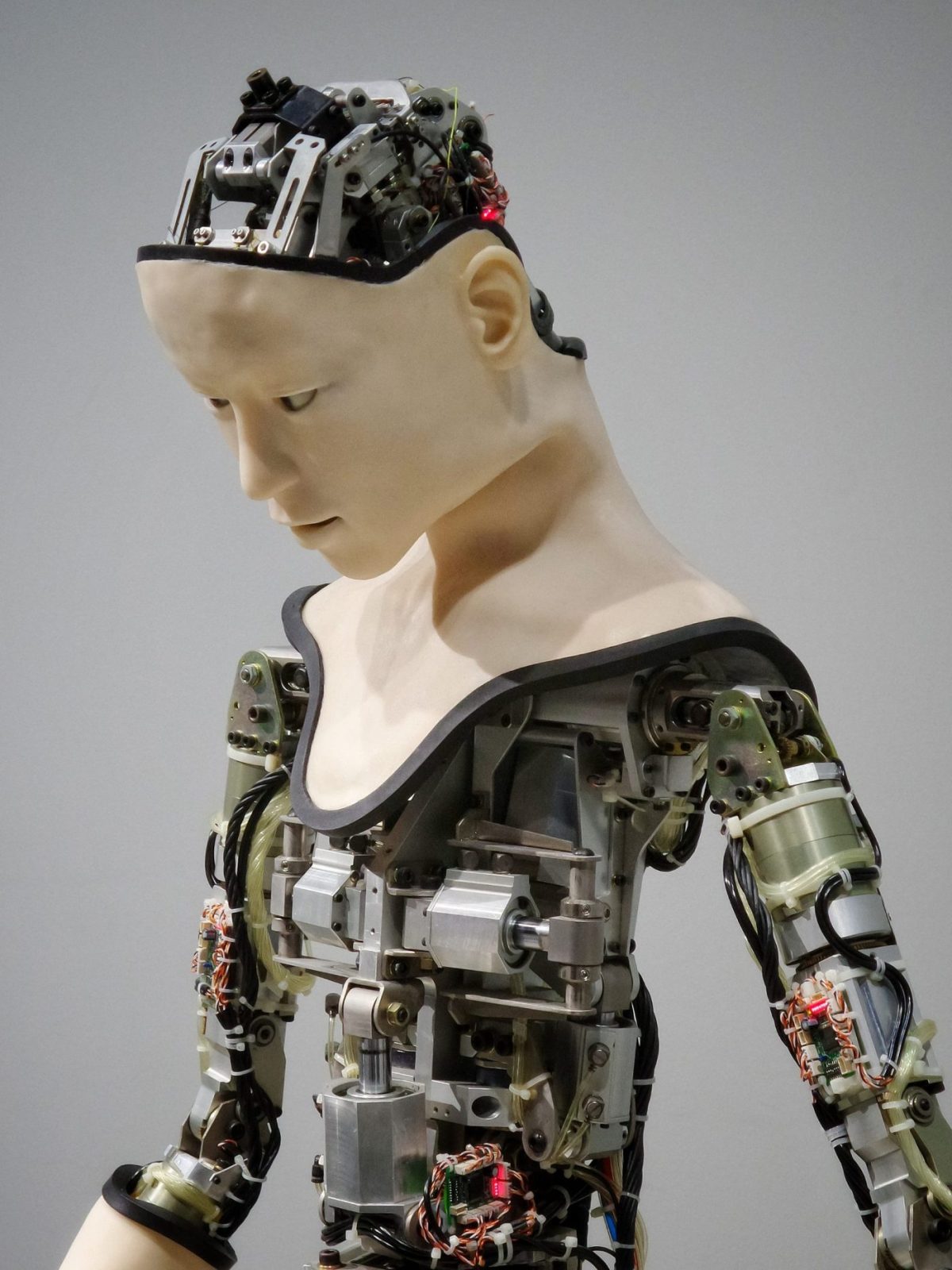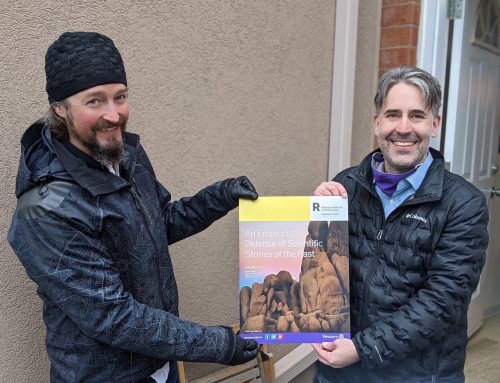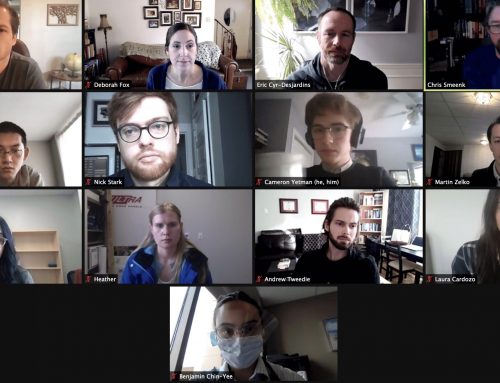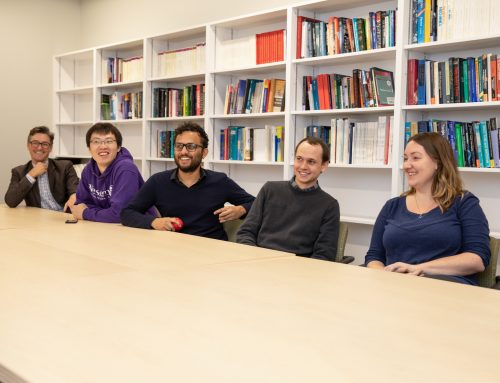Project Description and Outcomes
Over the summer of 2023, I worked with FIMS LIS PhD student Daniel Arauz Nuñez (the project RA) to develop literature review and perform scoping work for the project “Developing Limits for Inference in AI/ML Automated Decision-Making.” This research is grounded in an initial conceptual article recently published in BJHS Themes which argues so-called “conjectural” forms of narrative inference are fundamental to the logics of contemporary machine learning technologies. The aim of the current phase of the project is to develop a robust and granular heuristic taxonomy to assess ML systems for both their conceptual assumptions as well as their proposed use cases. This taxonomy is grounded in analysis of the forms of inferential reasoning involved in a particular automated analysis and the domain in which the analysis is being performed.
During the summer the project RA and I began to gather and analyze material from three broad categories of documents in support of this taxonomy. These categories included: a) primary and secondary source materials focusing on the philosophy of statistical inference and its application to human bodies and behavior; b) academic papers regarding and documentation for machine learning systems use to make such
inferences; and c) legal and regulatory proposals for the governance of machine learning technologies that engage explicitly or implicitly with inference-based automated decision-making. In addition, the project RA and I performed joint close reading of two texts central to the project: Ian Hacking’s The Emergence of Probability and The Taming of Chance. The project RA also used the bibliographic wok of the project literature review to augment their Comprehensive Exam reading list.
Going forward, the project RA and I are continuing the development of this taxonomy of inference with further support from the Faculty of Information and Media Studies and from the Schwartz Reisman Institute for Technology and Society at the University of Toronto. I thank the Rotman Centre for their generous and helpful support of the project PA through this summer funding.
– Luke Stark
Project Description and Outcomes
Despite significant concern surrounding the harms of Artificial Intelligence (AI), there has been little explicit discussion as to what exactly constitutes ‘harm’ when looking at the impacts of this technology. This is a serious omission. Without a clear conceptual definition of harm to draw on when developing regulatory frameworks or making policy decisions regarding AI, we’re left to rely on intuitive notions of harm prone to biases, inconsistencies, and other inaccuracies. Moreover, though appealing to the extant philosophical literature on harm may seem like a natural solution to this problem, standard accounts of harm are similarly ill-fit to address the harms of AI. The current harm scholarship relies on a ‘highly idealized’ view of harm (Dea 2020, 304). As a result, accounts often ignore the impacts of social and structural factors on experiences of harm (Miller 2022), offering conceptions that fail to accurately account for real world harms like those of AI (Dea 2020). Given that harm is an important tool for understanding and addressing the effects of this technology (Smuha 2021), the aim of this project was to construct a novel account of AI harm – one that understands harm in a relational sense and can address AI’s disproportionate impacts on members of marginalized groups (Birhane 2021).
Under the supervision of Dr. Carolyn McLeod, Clair first conducted a review of the literature on AI harm, drawing on work from areas including computer science, AI governance and law, and philosophy of technology. This allowed her to develop a comprehensive account of the role harm plays in this interdisciplinary literature and influenced her conceptual analysis of AI harm. In conducting this analysis, Clair engaged with 1) existing philosophical literature on harm, 2) criticisms regarding the idealized nature of this literature, and 3) insights from feminist work on relationality, which emphasize how social and systemic factors impact well-being. From this, she then developed a novel account of AI harm, where harm is conceptualized as adverse impacts on relational well-being.
The outputs of this project include a paper that will be submitted for publication to a peer reviewed journal. In addition, the research on AI harm will be used in one of Clair’s dissertation chapters, which focuses on applying harm reduction methods to the use of AI. As part of the progress toward these outputs, Clair presented stages of her research in the summer at the International Conference on Computer Ethics: Philosophical Enquiry (CEPE 2023), at the Canadian Society for the Study of Practical Ethics (CSSPE) Conference, and at Dalhousie’s Law and Technology Institute for a workshop on ‘Law and Ethics of AI & Technology.’ This research also contributed to a blog post on harm for the American Philosophical Association (APA), and a presentation on feminist philosophy and harm at the Canadian Philosophical Association (CPA) conference.
Project Description and Outcomes
My project had two aims: 1) to complete a paper on the role of diagrams/notation at some select points in the history of philosophy and science; 2) to complete work on translations relevant to this area of study and my dissertation. Concerning the first aim, I was forced to reconsider some of the central concepts. For instance, I had originally insisted that the notion of fiction (as developed by Salomon Maimon) would be useful in accounting for the schematic rendering of an object (behaving as if the constructed relations hold for the object). For reasons I cannot elaborate here, fiction in this sense is valid only under the regulative assumption that there is an isomorphism between empirical space and the pure space of geometrical constructions (which is assumed to be Euclidean). Ignoring the tenuousness of this assumption, it is difficult to explain the efficacy of other kinds of diagrams whose objects are not equally composed of the same kinds of relations (e.g. quantitative spatial relations). For example, a category theoretic product models the relation of conjunction in Peirce’s alpha graphs, yet this does not ‘reduce’ logical or graphical relations to categorical ones. I am currently addressing the question of how to discuss structural similarity without reduction. Fiction, as it is conceived in the context of transcendental idealism, runs into some problems when considering contemporary diagrammatic tools.
Concerning the second aim, I have been working on two translations. The first, which I have completed, is a section from Salomon Maimon’s Philosophisches Wörterbuch (1791) titled “Apprehension and Association of the Imagination.” This section complements my previous translation of the section titled “Fiction,” in that Maimon engages in a kind of transcendental topic which Kant describes in Critique of Pure Reason. It is an attempt at situating the various kinds of representations in their proper place within the faculties of the mind. Here, Maimon distinguishes between two functions of the imagination, a real one and a fictive one. The former, apprehension, describes the production of space from the perception of heterogeneous objects. It is on this basis that the fictive function of the imagination abstracts spatial relations from empirical objects and represents them in a pure space without reference to objects of experience. In this pure space, constructed objects are inherently spatial (it is an internal determination of things) since this pure space must precede their construction since these objects are only delimitations of pure space. It is a fiction because it bears no relation to possible experience. It proceeds from the identity of a homogenous space without a sensible image and not from the sensible difference between heterogeneous objects. While he focuses on space, this is also true of time as well. This distinction allows Maimon to make the skeptical argument that we do not use concepts in experience. Instead, the spontaneous activity of the mind can only apply concepts to this pure space. Whatever rule the imagination follows to synthesize the manifold of experience is not actively mandated by the understanding. If we wish to avoid skepticism about the application of concepts to experience, we must assume (but cannot prove) an isomorphism between thought and experience. Though I have completed the first draft of this translation and will continue to edit it, mainly for stylistic reasons.
The second text I am translating is a short essay by Jean Cavaillès titled “Mathematics and Formalism” (1949), which is a posthumous text composed sometime between 1939 and 1943. He begins by outlining the panlogicist approach to the foundations of mathematics. Specifically, in the spirit of both Dedekind and Frege, it is the position that mathematics is a part of logic and nothing but a mechanical, though axiomatized, play of symbols. It is a program for an absolute, combinatorial formalism. Cavaillès quickly introduces some obstacles to this program, the first being that, given the totality of axioms will always be denumerable (each can be assigned a whole number), this poses problems for constructible objects which surpass the denumerable infinite. He cites the diagonal proof of a non-denumerable infinity of decimals between 0 and 1, as well as the set of all real or transcendental numbers (which one might have to assume in a particular argument). He also discusses a version of Gödel’s incompleteness proof. Ultimately, Cavaillès argues that absolute formalism ultimately fails because it cannot account for the fact that distinct areas of mathematics possess distinct modes of concatenation [enchaînement] in purely combinatorial terms. He calls these modes of concatenation gestures, which, although transmissible from one domain to another, do not refer to an all-encompassing formalism. As concerns my research, this essay outlines the problem Cavaillès is attempting to solve with his notion of gesture. This essay helps show that diagrammatic reasoning is productive not because of any one formalism it employs, but rather because it concerns the concrete gestures which animate and sometimes depart from a given formalism.
Project Description and Outcomes
Project Description
- Iris Marion Young’s “social connection model” has been applied to a wide range of large-scale ethical problems, such as climate change, public health disparities, and algorithmic injustice. Her model distinguishes between forward-looking responsibility (i.e., obligations) and backward-looking responsibility (i.e., liability/guilt). This project focuses on Young’s practical concern that a focus on guilt and blame prompts defensiveness, thus pushing individuals away from joining in collective movements towards justice. Drawing on restorative and transformative justice literatures, Emily argues that we can disentangle liability from punishment—thus refining Young’s model to include liability while still addressing her important practical concerns.
Project Outcomes
- This project uses the pressing issue of climate change as a primary example of structural injustice. By responding to critiques of the social connection model and taking Young’s often overlooked practical concerns seriously, this project aims to help us apply the social connection model in practice rather than in theory alone. Emily surveyed interdisciplinary literatures on structural injustice and transformative justice, producing a polished draft of this chapter for her integrated article doctoral thesis. The article was presented at Western’s Feminist Philosophy Research Group in October 2023. It will also be submitted for presentation at the 2024 CPA meeting, then submitted for publication in Hypatia, the Journal of Applied Philosophy, or Environmental Philosophy.
Project Description and Outcomes
From May to August of 2023, I spent 4 hours each day working on three papers concerning the Dowker-Kent set selection problem in the foundations of quantum theory. The set selection problem is the issue that there are cases where decoherence alone does not superselect a unique set of histories and instead admits an infinite number of consistent sets, which all differ on matters of fact. What then selects the empirically correct one? I reformulated this problem based on a certain argued for epistemological structure to quantum theory and then solved my newly formulated problem.
I argue that, to be empirically coherent, quantum theory must not rule out the possibility of epistemic agents with knowledge of apparatus-associated observables. In apparatus-independent language, a quantum theory of an experiment must not rule out knowledge of the basis to the space of the experiment’s possible histories. If one takes an epistemic agent to be an environmental record of a measurement, quantum theory must permit the existence of records of facts sufficient to derive this basis using the theory. In this work, I find that such an inference requires that quantum theory include a representation of certain interventions in quantum systems. Over the course of three papers, I show that, if the theory of interventions involved is 1) purely unitary quantum theory, 2) a dynamical collapse theory, or 3) process matrix quantum theory without causally ordered operators, then it must be supplemented with an assumption about its classical limit. This addition is necessary and sufficient for an epistemic agent to infer the basis of an experiment from knowledge of the theory, the intervention variables, and records of the effects of the interventions. However, the chosen classical limit of the local interventions affects the statistics of certain observables at a distance from the interventions, and I discuss the threat of superluminal signalling. Ultimately, my result is of significance to the structure and semantics of quantum theory and the communication of non-fungible quantum information.
For the first paper, I have written the arguments establishing that certain interventions must be represented within quantum theory to secure its empirical coherence. I have also completed the main arguments establishing that the basis of the Hamiltonian driving decoherence is necessary and sufficient to select the empirically correct Dowker-Kent set. Otherwise, I have already written an introduction and some of the conclusions. This amounts to around 35 pages. The work that remains is to fill in some background information about the structure of quantum theory and some background on the Consistent Histories interpretation and the set selection problem. I should finish this paper by the end of October.
For the second paper, I have written about the threat of superluminal signalling, which does not arise in the unitary case. This amounts to around 5 pages. As a shorter paper, the only work that remains is to provide some background about dynamical collapse theories. I should finish this paper in November. Most of the content is in a 15-page prospectus, also written over the summer.
For the third paper, I have written the arguments motivating the use of process matrix quantum theory without causal ordering of the interventions. I have adapted decoherence and the set selection problem to this setting. I have also completed the argument that a certain factorization of the quantum causal model of the decoherent process is sufficient to select the Dowker-Kent process. So far, this amounts to around 15 pages. I still need to establish that the factorization is necessary to select the Dowker-Kent process. I think that I will also complete this relatively short paper in November.
Project Description and Outcomes
In medical decision-making, patients who are deemed capable have a right to make autonomous decisions. Children are often assumed to lack capacity to make medical decisions, so the task is assigned to their substitute decision maker (SDM). The “best interests standard” is intended to protect children from an SDM acting in their own interests, but has been criticized for being vague, applied inconsistently, and subject to abuse. Our team, comprised of Jacob Shelley, Claire Houston, Gail Teachman, and three Rotman resident members, in collaboration with SickKids, conducted a scoping to understand how the best interests standard is discussed across disciplines including law, applied ethics, policy, and health-related literature, with an aim to improve decision-making in this area. We received a SSHRC Insight Development Grant under the leadership of Dr. Jacob Shelley to fund this project, as well as Rotman’s Graduate Student Fellowship funding.
The focus of the project during this summer was knowledge dissemination. Micaela’s work was integral in sharing the interim results of our project -a scoping review on the best interests standard in children’s decision-making- with important stakeholders at various national conferences. Micaela and fellow Rotman member Zoe Ritchie created and ran a 3-hour workshop for the Canadian Bioethics Society Workshop and Community Forum that promoted interdisciplinary conversation and debate surrounding children’s medical decision-making. Both Rotman students also co-presented at the Child Health Symposium at Western University to share project findings and hot topics that emerged from the workshop with researchers and students focused on child health. The Faculty of Law is also supporting Zoe and Micaela, in association with the SSHRC grant project, to attend The American Society of Bioethics & Humanities Annual Conference in Baltimore this October.
Thank you to the Rotman Graduate Student Fellowship for making this work possible.
M. Forte, Z. Ritchie, J. Shelley, M. Smith. “Finding the best practice in best interests?” Child Health Symposium, London, ON. May 30, 2023. Contribution: co-presenter.
Z. Ritchie, M. Forte, C. Houston, M. Smith, J. Shelley. “How ought the best interests of children be considered in medical decision making? Legal and Ethical Perspectives.” Canadian Journal of Bioethics, November 2023 Issue. Status: invited submission.
Z. Ritchie, M. Forte, L. Soparlo, J. Shelley, M. Smith. How ought the best interests of children be considered in medical decision-making? A collaborative workshop toward a consistent and reliable guide. Canadian Bioethics Society Workshop and Community Forum. Workshop. May 15-18, 2023.
Project Description and Outcomes
Project Description: The effect of cognitive evaluation on emotional experience, either in the form of a judgment, thought, or belief, is straightforward and has received much attention in the literature. The main idea is that emotions are elicited by cognitive evaluations of the objects, events, or the environment that led to an emotional experience. Although this seems to hold at least for paradigm cases of emotional experience, it is an open question as to whether moods also exhibit such a connection to evaluations. For example, when someone is anxious, knowing that her own anxiousness is not well-rooted, or someone’s pointing out the ways that she can overcome her anxious state of mind doesn’t seem to help alter their anxious mood. This gives us a reason to think that moods are not belief-responsive—they don’t respond to changes in belief or judgment. This project aims to develop an account of moods that accommodates belief formation processes by emphasizing the effect of implicit appraisals on mood changes.
Project Outcomes: Küçük conducted a literature review on the belief formation process and its effect on mood changes, drawing both on philosophical and empirical literature. Noticing that empirical literature has been dominated by utilization of dynamical models in capturing this relationship, Küçük’s interests have shifted towards understanding the nature of dynamical models and their role in explicating the relationship between mental phenomena, broadly construed. Küçük drafted a paper, titled, “Explaining through Dynamics: Why the Mechanistic Account Isn’t Enough”, and she presented this paper at Bilkent University Philosophy Colloquium on October 19th. Küçük is planning to further this project by presenting it at EMRG Lab meetings, revise the paper, and explore the opportunities for publication.
Jaipreet Mattu’s 2023 Summer Research Project centers on an emerging philosophical debate within the psychedelic research community. This discussion revolves around whether the concept of “mysticism” aligns with naturalism and the scientific worldview and thus questions the use of studying mystical experiences in psychedelic science. In collaboration with Dr. Chris Letheby and Dr. Eric Hochstein, Jaipreet is working on a co-authored paper aimed at addressing this debate. Their objective is to resolve what they deem the “mysticism wars” and establish a clear understanding of the various perspectives involved in the debate. This paper has already been commissioned for a volume on The Palgrave Handbook of Philosophy and Psychoactive Drug Use by Palgrave Macmillan, edited by Dr. Rob Lovering. It will be published in 2024.
Project Description and Outcomes
Project Description: In medical decision making, capable patients have a right to make autonomous decisions. Yet, this principle is often challenged if the patient is a child. Children are often assumed to lack capacity or maturity to make medical decisions, so the task is assigned to the child’s substitute decision maker (SDM), who makes decisions on the child’s behalf. A SDM is supposed to be guided by what is in the child’s “best interests”. Despite being the prevailing ethical principle in pediatric ethics, the best interest standard has faced criticism for being vague, applied inconsistently, and subject to abuse. The result is a confusing body of guidance to assist with making decisions about children’s medical care. Our project seeks to systematically understand how the best interests standard is applied in diverse medical settings with the aim of improving clinical decision-making in this area. The HELP Lab has received a SSHRC Insight Development Grant under the leadership of Dr. Jacob Shelley to fund a project that seeks to provide clarification around the best interests standard.
Project Outcomes: During the Fellowship, Zoe played a critical role in advancing one of our main knowledge dissemination products on the SSHRC grant–a scoping review on the best interests standard in children’s decision-making. Zoe led alongside fellow Rotman student member Micaela Forte, a 3-hour afternoon workshop at the Canadian Bioethics Society Workshop and Community Forum with a subsequent workshop summary they are preparing for the Canadian Journal of Bioethics. Zoe supported Micaela co-presenting at the Child Health Symposium presented by Western over the summer. The Faculty of Law is also supporting Zoe and Micaela, in association with the SSHRC grant project, to attend The American Society of Bioethics & Humanities Annual Conference in Baltimore this October.
Z. Ritchie, M. Forte, C. Houston, M. Smith, J. Shelley. “How ought the best interests of children be considered in medical decision making? Legal and Ethical Perspectives.” Canadian Journal of Bioethics, November 2023 Issue. Status: invited submission.
Z. Ritchie, M. Forte, L. Soparlo, J. Shelley, M. Smith. How ought the best interests of children be considered in medical decision-making? A collaborative workshop toward a consistent and reliable guide. Canadian Bioethics Society Workshop and Community Forum. Workshop. May 15-18, 2023.
M. Forte, Z. Ritchie, J. Shelley, M. Smith. “Finding the best practice in best interests?” Child Health Symposium, London, ON. May 30, 2023. Contribution: co-presenter.
Project Description and Outcomes
Pascal Rodríguez-Warnier performed research on Bohr’s views on quantum mechanics from May to August 2023, supervised by Prof. Francesca Vidotto, and co-supervised by Prof. Wayne Myrvold. The investigation was divided into two parts.
From May to June: Pascal carried out the historical research and got deeply engaged with Bohr’s writings. The main result of this period is the recognition that Bohr never held an instrumentalist view about quantum mechanics. His doctrine of classical concepts, associated with the idea that quantum mechanics shall be expressed in classical language, is rooted in the need to account for direct human experience and communication between scientists.
From July to August: Unlike the previous months, which were devoted to clarifying misconceptions of Bohr’s writings, during this period Pascal proposed his view about what is a more accurate way to understand the work of the Danish physicist. The central element lies in physical perspectivism, according to which quantum systems have well-defined values only relative to a set a context, characterised by physical variables. Such a context is the physical perspective.
The results of these two periods were discussed with the supervisor and co-supervisor at different stages. The main instance for public feedback was after a practice talk given by Pascal at the Rotman Institute with the presence of the supervisors and the faculty members of the Rotman Institute specialised in philosophy of physics. The paper on this shall be written after having received more feedback from the specialised community.
The work done during the previous months sets the conceptual basis for the second phase, which consists of the application of Bohrian perspectivism to the foundations of quantum information theory and the literature on quantum reference frames. This is still a work in progress and Pascal aims to discuss it and receive feedback from his graduate colleagues on the relevance of this project at the BBLOC graduate conference in London, UK. This feedback will be crucial for the following stages of the project.
Outcomes:
–Perspectivist Elements in Bohrian Quantum Mechanics. Practice talk at the Rotman Institute of Philosophy. 28 September. London, ON.
–Perspectivist Elements in Bohrian Quantum Mechanics. Perspectivism and Quantum Mechanics. 4 October 2023. University of Graz. Online.
Abstracts under peer-review for conferences.
–Bohrian Perspectivism. HOPOS24. 9-12 July 2024. Vienna. https://hopos2024.univie.ac.at/
–Bohrian Lessons for Quantum Information and Quantum Reference Frames. BBLOC Graduate Workshop. 14 December 2023. London.
–Bohr, Quantum Information and Reference Frames. Philosophy of Physics Society at Pacific APA. 20-23 March 2024. Portland.
Project Description and Outcomes
There has been a growing overlap between the social and cognitive sciences in recent decades, with cognitive social scientists looking to align the former with the latter. Researchers have pointed to the French sociologist Pierre Bourdieu’s concept of habitus — embodied structures of dispositions acquired by agents engaging with a structured social world (Bourdieu, 1990) — as a promising sociological building block for an embodied cognitive social science (ECSS) (Cerulo, 2019; Ingold, 2000; Lizardo, 2019), but little sustained work has been done till date. While practitioners have attempted to construct sociopsychological explanations of behavior by linking habitus to models from cognitive science, such as connectionist models (Turner, 2002) and Piagetian structuralist models (Lizardo, 2004), the onto-methodological commitments of such accounts remain under-explained. For instance, how do sociopsychological explanations work? Does a pre-structured social world exist independently of individuals? If so, how does this world relate to an agent’s psychology or habitus? In other words, how to explain the relation between the ‘social’ and the ‘individual’?
As a first step towards illuminating the onto-methodological foundations of ECSS, this project sought to excavate Bourdieu’s understanding of the ‘social.’ For Bourdieu (2020), the social world ought to be methodologically grasped not by analyzing the visible interactions between individuals but by investigating the field of invisible relations underpinning those interactions. Why? Well, following Durkheim, Bourdieu makes an epistemological break with everyday experience to study the social world independently of agents experiences’ of it (Bourdieu et al., 1991). According to Bourdieu (1990), agents’ subjective experiences, rather than an element in the explanation of social reality, must itself be accounted for by that reality by reference to the social fields that they inhabit. A field-theoretical approach breaks with the substantialist or Aristotelian mode of thinking, which consider things in themselves, to offer a relational or Galilean approach for understanding the social world as a system of relations in which individuals and their interactions are products of the field (Bourdieu, 2020). Unlike interactionist approaches, such as symbolic interactionism or phenomenology, which attempt to find the explanatory principles of behavior in the interactions between agents, a field approach, Bourdieu argues, captures the sources of behavior in the fields that agents inhabit (Bourdieu, 2020). The advantages of using the notion of field are that (1) it provides general principles for understanding social universes that take the form of a field, and (2) orients and governs empirical research by enabling researchers to investigate the properties of the field and of those in it (Bourdieu, 2004).
While ECSS practitioners have largely put the weight of explanation on the side of the agent in their bid to provide cognitive foundations for habitus, Bourdieu’s field approach calls for a need to shift the weight of explanation onto the relation between the social environment and agents for understanding habitus. The next phase of the project will explore the relation between fields and habitus, which will inform a chapter in the project lead’s (Varun Ravikumar, PhD Candidate in Philosophy, Western University; vraviku@uwo.ca) dissertation.
References
See here for the list of references (you will need a Gmail account for access).
Project Description and Outcomes
A physics-specific theory of analogy is a tool for assessing the pursuit-worthiness and persuasiveness1 of arguments by analogy in physics. Our research revolves around sketching and applying a physics-specific theory of analogy. As an example, we use the analogy between black holes and sonic black holes which we analyze in an extended version. Our research had three main findings:
1) Hesse´s (1966) theory of analogy can be updated and narrowed down to the domain of physics. We have modified Hesse´s s requirement for relevancy by reforging her criteria for observability. Furthermore, we have supplemented Hesse´s requirement for relevancy by adding robustness and common causation as two additional components. We have used Chang´s (2005) view of observability, Schupbach´s (2018) view of robustness and Reichenbach´s (1956) view of common causality. We have switched Hesse´s causation requirement for probabilistic causation and clarified her no-essential difference requirement by relating it to observability and relevancy. Thus, we have created a new physics-specific theory of analogy.
2)We have applied our theory to the analogy between black holes and sonic black holes suggested by Unruh (1980) and Visser (1999). We have found that most of the similarities identified by Visser and Unruh satisfy our criteria and concluded that the proposed analogy seems compelling and pursue-worthy. However, if one takes metric as one of the similar properties between black holes and sonic black holes, it seems that this creates a problem for the persuasiveness of the analogy. Namely, the property of having a metric g doesn’t seem to fare well regarding our criteria.
3)Due to the problem mentioned above, we have extended the analogy by modifying the metric in the fluid side (Euler equation) to include the Newtonian gravitational potential and external forces. The gravitational potential and external forces could (in principle) be defined in exactly the same terms on the GR side. This makes the modified metric fit better with our criteria as on the GR side, instead of abstract coordinates, we now have gravitational potential and external forces that are much more ´palpable´. However, the full analysis is still pending.
We would also like to note that we presented our findings at the European Association of Philosophy of Science conference in Belgrade, Serbia on 22. Of September in the format of a poster. Currently, we are working on a paper where we hope to finalize our research and provide details of our findings. As a supplement to this report, provided is the poster that we presented at EPSA 2023.






